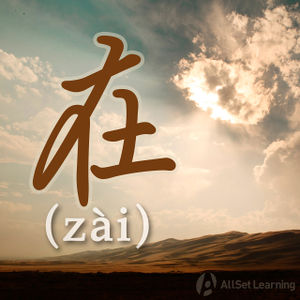Difference between revisions of "Indicating location with "zai" before verbs"
| Line 5: | Line 5: | ||
== Structure == | == Structure == | ||
| − | To indicate the location that a verb takes place in, 在 is used. | + | To indicate the location that a verb takes place in, 在 (zai) is used. |
<div class="jiegou"> | <div class="jiegou"> | ||
| Line 13: | Line 13: | ||
</div> | </div> | ||
| − | Notice that the location is placed ''before'' the verb in Chinese, whereas it appears afterwards in English. And often you need a "里" with "在",after a thing to indicate the location. | + | Notice that the location is placed ''before'' the verb in Chinese, whereas it appears afterwards in English. And often you need a "里 (lǐ)" with "在 (zai)",after a thing to indicate the location. |
== Examples == | == Examples == | ||
Revision as of 05:47, 15 October 2014
-
Level
-
Similar to
-
Used for
-
Keywords
When you want to express the place in which you do something, you can use 在 (zai).
Structure
To indicate the location that a verb takes place in, 在 (zai) is used.
Subject + 在 + Location + Verb + Object
Notice that the location is placed before the verb in Chinese, whereas it appears afterwards in English. And often you need a "里 (lǐ)" with "在 (zai)",after a thing to indicate the location.
Examples
- 我 在 上海 工作。I am working in Shanghai.
- 我 在 酒吧 喝 酒。I am drinking at the bar.
- 他 在 图书馆 看 书。He is reading in the library.
- 我 在 这 个 公司工作。 I work at this company.
- 我 周末 要 在 家 睡觉。During the weekend, I want to sleep at home.
- 不 要 在 床 上 吃 东西。need a "上" with "在" to indicate the location " on the bed". Don't eat food on the bed.
- 我 想 在 家 开 一 个 派对。I want to have a party at my home.
- 他 喜欢 在 厕所 里 抽 烟。need a "里" with "在" to indicate the location " in the bathroom".He likes to smoke while he's in the bathroom.
- 很 多 人在 地铁 里 吃 包子。need a "里" with "在" to indicate the location " in the subway". Many people eat baozi while in the subway.
- 现在 我们 在 KTV 唱 歌。Now we're at KTV singing songs.
Notice that in English we usually put the location at the end of a sentence. This is different in Chinese, as we put the location after the subject but before the verb.



